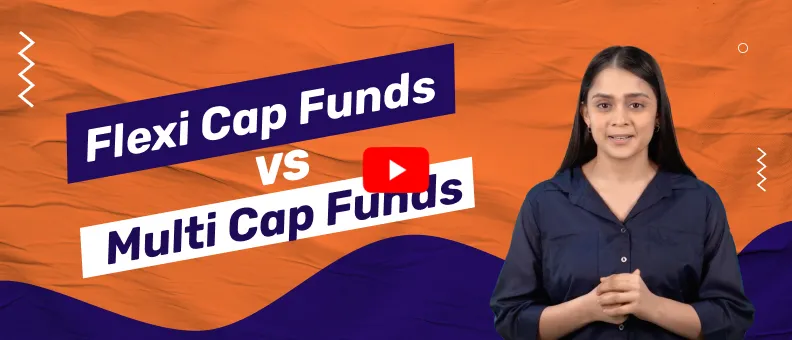Flexi-Cap Funds vs Multi-Cap Funds: Where to Invest


Flexi cap funds were introduced by the Securities and Exchange Board of India (SEBI) in 2020 after revising the multi cap fund segment. While the segregation has been quite clear, many investors are still confused over the two types of equity funds and often wonder which one to go for. Additionally, most investors are unaware that they can follow both, a flexi cap and multi cap fund investment strategy and derive benefits from either investment vehicle.
Let’s find out if it is a good idea to invest in both, a flexi cap fund and a multi cap fund.
- Table of contents:
- What are multi cap mutual funds?
- What are flexi cap mutual funds?
- Key features of flexi cap funds and multi cap funds
- Major differences between flexi cap funds and multi cap funds
- Should one invest in both flexi cap and multi cap funds?
- Why you should invest in the Bajaj Finserv Flexi Cap Fund
- Flexi cap vs multi cap Funds: which is better for you
What are multi cap mutual funds?
A multi cap fund is a type of equity fund that invests large cap, mid cap as well as small cap companies. The fund must invest at least 25% of its portfolio to each market capitalization category.
Large cap companies are the top 100 listed companies in the country’s major stock market indices. These are typically industry leaders with a track record of consistent performance. Mid cap companies are ranked between 101-250 on the stock market index. Small cap companies are those ranked 250 and beyond. By investing in companies of various sizes, multi cap funds seek to combine the significant long-term growth potential of small cap and mid cap companies with the relative stability of large cap firms.
Read Also: Why should you consider investing in a multi-cap fund?
What are flexi cap mutual funds?
Like multi cap funds, flexi cap funds can also invest in large, mid and small cap companies. However, while multi cap funds must ensure a 25% allocation to each, flexi cap funds do not have to comply with any minimum allocation requirements. Flexi cap funds must invest at least 65% of their portfolios in equities, but are free to distribute investments across large, mid and small cap stocks as per their investment strategy and market conditions.
For instance, during volatility, they may increase the weightage of large cap stocks to add relative stability to the portfolio. When the market is primed for growth, they may increase the mid cap and small cap segments of the portfolio.
Read Also: Understanding Flexi Cap Mutual Funds
Key features of flexi cap funds and multi cap funds
Whether you are planning to follow a flexi cap and multi cap fund investment strategy or invest in one of them at a time, you must know the key features of these schemes.
• Risk-to-reward ratio: Both multi cap funds and flexi cap funds fall in the high-risk category on the riskometer. However, the risk-to-reward ratio of flexi cap funds is relatively better than multi cap funds because flexi cap funds are more flexible and can tap into an arising investment opportunity by allocating more assets to it. Multi cap funds can follow a similar strategy, but in a limited capacity, as they must maintain a minimum of 25% asset allocation across market caps.
• Market conditions: Multi cap funds may have a relatively better return potential than flexi cap funds in a bull market phase. Inversely, flexi cap funds may usually perform better than multi cap funds in a bear market phase. This is yet another reason why you must consider investing in both flexi cap funds and multi cap funds.
• Comparison with other equity schemes: Both multi cap funds and flexi cap funds can provide relatively better return potential than pure large-cap funds and large and mid-cap funds. They are also relatively less risky than pure mid-cap and pure small-cap funds. And since one of them performs better in bull runs and the other in bear runs, it is advisable to follow a concurrent flexi cap and multi cap fund investment strategy.
• Volatility: Flexi cap funds are usually less volatile than multi cap funds. This is because the volatility factor usually comes from investing in mid-cap and small-cap companies in emerging sectors. While flexi funds can drop their asset allocations in these segments, multi cap funds must maintain the 25% asset allocation mandated by SEBI irrespective of market conditions.
Major differences between flexi cap funds and multi cap funds?
| Criteria | Multi Cap Funds | Flexi Cap Funds |
|---|---|---|
| Portfolio composition | Invests in large, mid and small cap companies; minimum 25% allocation to each | Can invest in large, mid and small cap companies; no minimum allocation requirement |
| Flexibility | Limited flexibility | Highly flexible, fund managers can change allocation patterns as per their strategy and market conditions |
| Return potential | Higher return potential but also higher volatility due to fixed minimum allocations in smaller caps | Can adjust to market conditions, potentially offering more stable returns |
| Risk | Very high because at least 50% portfolio is allocated to mid and small cap stocks | Depends on portfolio composition, high weightage to large cap stocks can increase portfolio stability |
Should one invest in both flexi cap and multi cap funds?
You should consider investing in both multi cap funds and flexi cap funds if:
• You have a high-risk appetite.
• You have a longer investment horizon of at least 5 years.
• You want to utilise the investment opportunities across market capitalisations and industry segments.
• You are a young investor who wants to create long term wealth.
• You want to add multiple dynamic investment options to your portfolio.
Reasons to invest in Bajaj Finserv Flexi Cap Fund
The Bajaj Finserv Flexi Cap Fund aims to generate long-term capital appreciation by following megatrends strategy. This scheme invests in equity, debt, and money market instruments across market caps and industries. You can choose this Bajaj Finserv mutual fund scheme to add a dynamic mutual fund with growth potential to your portfolio. The good part is that you can get started with a small amount. You also have the option to make a lumpsum investment or start a Systematic Investment Plan (SIP) depending on your investment goals. However, it is always advisable to consult a financial advisor before making any decisions.
Flexi cap vs multi cap Funds: which is better for you
Choosing between flexi cap and multi cap funds depends on your investment horizon, risk profile, and financial goals.
Flexi cap funds offer flexibility to invest across large, mid, and small cap stocks based on market conditions, which may help manage risk and capture potential opportunities. Multi cap funds follow a fixed allocation across market capitalisations, providing structured diversification. Investors with a higher risk appetite and longer horizon may benefit from flexi cap funds’ active allocation, while those preferring a balanced, relatively stable approach might consider multi cap funds.
There is no one-size-fits-all option; suitability varies by individual objectives and risk tolerance.
Conclusion
In conclusion, both flexi cap fund and multi cap fund schemes have their pros and cons and appeal to different types of investors. You can adopt the flexi cap and multi cap fund investment strategy if you have the resources. Or you can first add a flexi cap fund to your portfolio and add other investment products later based on your needs.
FAQs
Which is better flexi-cap or multi-cap?
Different investors may prefer different schemes. A flexi cap fund may be more suitable for those who seek a portfolio that can flexibly adapt to market conditions. It may also suit those who want relative stability during volatile times through increased allocation to large cap stocks. However, those seeking guaranteed exposure to all three market capitalisations may prefer multi cap funds. Investors who want to minimise potential fund manager bias may also prefer multi cap funds to the dynamically managed flexi cap funds.
How to choose between flexi cap fund and multi cap fund?
Your investment horizon and risk tolerance will determine whether you choose a flexi-cap fund or a multi-cap fund. A multi-cap fund is an option if you are comfortable with the volatility that comes with a 50% exposure to mid and small-cap equities. Alternately, you might choose a flexi cap fund, which typically only allocates 25–30% of its assets to mid and small-size equities depending on market conditions.
What are the factors that determine the returns from these funds?
The returns of a mutual fund are influenced by a number of variables, including the investing strategy, the state of the market, and the fund manager's experience. Equity funds that spread their holdings across various market capitalizations and industries include flexi-cap and multi-cap funds.
Related Searches:
Mutual Fund investments are subject to market risks, read all scheme related documents carefully.
This document should not be treated as endorsement of the views / opinions or as an investment advice. This document should not be construed as a research report or a recommendation to buy or sell any security. This document is for information purpose only and should not be construed as a promise on minimum returns or safeguard of capital. This document alone is not sufficient and should not be used for the development or implementation of an investment strategy. The recipient should note and understand that the information provided above may not contain all the material aspects relevant for making an investment decision. Investors are advised to consult their own investment advisor before making any investment decision in light of their risk appetite, investment goals and horizon. This information is subject to change without any prior notice.
Mutual Fund investments are subject to market risks, read all scheme related documents carefully.
This document should not be treated as endorsement of the views/opinions or as investment advice. This document should not be construed as a research report or a recommendation to buy or sell any security. This document is for information purpose only and should not be construed as a promise on minimum returns or safeguard of capital. This document alone is not sufficient and should not be used for the development or implementation of an investment strategy. The recipient should note and understand that the information provided above may not contain all the material aspects relevant for making an investment decision. Investors are advised to consult their own investment advisor before making any investment decision in light of their risk appetite, investment goals and horizon. This information is subject to change without any prior notice.
The content herein has been prepared on the basis of publicly available information believed to be reliable. However, Bajaj Finserv Asset Management Ltd. does not guarantee the accuracy of such information, assure its completeness or warrant such information will not be changed. The tax information (if any) in this article is based on prevailing laws at the time of publishing the article and is subject to change. Please consult a tax professional or refer to the latest regulations for up-to-date information.